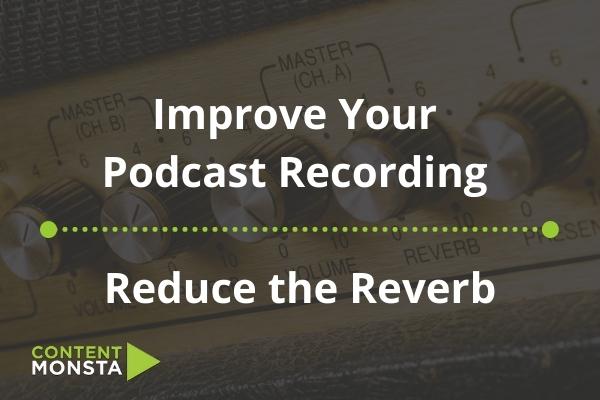The most simple way to improve your podcast recording is to reduce the reverb in your recording setting. One of the differences between an amateur and a professional podcast is the amount of reverb that makes it onto your recording.
Reverberation (reverb) can make your podcast sound echoey and can reduce the crispness of your audio quality.
While high-quality recording equipment and software can go some way to reducing the amount of reverb in your podcast, the most important factor to consider when trying to reduce reverb is the shape, size and makeup of your podcast recording studio.
Although we don’t expect anyone to do all of these steps, here are several things that you can do to improve podcast recording in your home studio to get the best quality possible – using any of these suggestions.
What is Reverb (reverberation)?
To know how to reduce reverberation we should first have some understanding of what reverberation is and how it is caused.
In the context of recording spoken word, reverberation is when the microphone picks up the sound of your voice coming from a source other than you. This causes the recording itself to sound hollow and makes it hard to hear what the podcaster is saying.
Reverb is caused by sound waves bouncing off objects and being reflected back towards their original source.
Therefore to reduce reverberation we need to reduce the extent to which sound waves are reflected within a room, particularly when this reflection directs the sound waves back towards the podcaster’s microphone.
Record in a small, evenly shaped room
Recording in a smaller room reduces the amount of space that sound waves have to “bounce” around, thereby reducing the amount of reverb that makes it onto your podcast recording.
Since sound waves can bounce off surfaces adjacent to you, as well as those directly in front and behind you, it’s also well worth trying to record in an evenly shaped room and to sit as close to the middle of the room as possible.
This means that you will not have an uneven level of reverberation on either side of you as you record as this could make audio distortion even worse.
This is the reason why a lot of guides say that you should record your podcast in a walk-in closet if you have one, as they are small and narrow. If you are not lucky enough to have a walk-in closet in your home, a small office should still be a good enough option.
Put soft furnishings on the surfaces in front and behind you
Sound reflects off surfaces in a similar way that light does. This means that harder, smoother surfaces reflect sound more efficiently than softer surfaces.
Softening up the surfaces in your recording room should therefore reduce the amount of reverberation in your podcast.
Try to focus on softening the surfaces immediately in front of and behind you when you record. You should prioritize these because sound waves tend to bounce back and forth in roughly the same spot.
Some ways that you can soften these hard surfaces include:
- If there is a window in front of you then draw the curtains or blinds
- Cover the walls in canvasses
- Have a house plant in front of the wall directly behind you
- Put any table in your recording room directly behind you and cover it with clothes or cushions
A lot of podcasters record their podcasts directly in front of a monitor without realizing that this means they are speaking directly at a reflective surface. If you are doing this then cover the monitor with a blanket to reduce the amount of sound that is reflected off of it.
Fill out the corners of your room
The corners of a room are one of the most vulnerable areas for creating reverb as surfaces directly meet at this point. This allows for sound to bounce rapidly off of these corners and creates a lot of echo, some of which will likely be picked up by your microphone.
You can significantly reduce the extent to which this type of echoing occurs by putting objects in the corners of your room.
Pretty much any object will do here, including bins, furniture, and other household items. You just want to block the straight path from one adjacent wall to another.
Focus on blocking the corners that you sit closest to when you record. You can also eliminate the amount of reverb that is created in the corners of your room by sitting as far away from each corner as possible (in the middle of your room).
Acoustic treatment on a budget
If the above methods have not taken your podcast’s audio to where you want it to be, there are some inexpensive paid ways to reduce reverberation.
To ensure that you get value for money when acoustically treating your room, you need to know which areas of your room most require this treatment. As we have said before, the areas of your room where you can expect most reverberation are:
- Right in front of where you speak
- The corners of the room
- The wall directly behind you
You will therefore get the best value for money if you buy products that directly reduce reverberation in these parts of your room.
To reduce reverberation directly in front of you, we’d recommend purchasing a microphone isolation shield. This is essentially a spongy layer that goes just behind and beside your microphone and “soaks up” the sound waves at their source.
They typically cost around $100, but you can also DIY one by putting a pillow in a shoebox and putting your microphone in there.
Corners can be acoustically treated with corner bass traps. These essentially large sponge strips fit into the corners of your room and block sound waves from bouncing off directly adjacent walls.
Walls themselves can be treated using acoustic panels. These are similar to bass traps but are flat and can be mounted on walls.
For most podcasters, using a microphone isolation shield alone should be enough to create a crisp, professional-sounding podcast. Bass traps and acoustic panels are only for those who want to squeeze every last drop of sound quality out of their podcast.
Key takeaway
Reverberation is the most common cause of poor podcast audio quality, however, you can significantly reduce reverb by setting up your podcasting room in the right way.
The majority of this can be done in a DIY fashion, however, there are also some pieces of acoustic treatment equipment for those who need it.
If you are looking to create crisp, professional-sounding podcasts from your office or home, Content Monsta can help with your production and promotion. Contact our team and let’s have a conversation.
This article was written by Volodymyr Barabakh, the Project Director of residential design and build company Fortress Home. For more information please visit: https://fortresshome.com/

How Much Does it Cost to Hire a Podcast Production Company?
A quick breakdown of what it should cost to hire a podcast production company to help you with your podcast production and promotion.

36 Video and Podcast Content Frequently Asked Questions
Expert answers to remote podcast and video production questions. How remote recording works, options for support, pricing, ROI, and analytics.

AI + Human Powered Content Marketing: Speed Without the AI Slop
FAST, CHEAP, and GOOD. You can have them all. Speed keeps coming up in client conversations, and for good reason. The meaning of speed has changed. Fast used to mean




